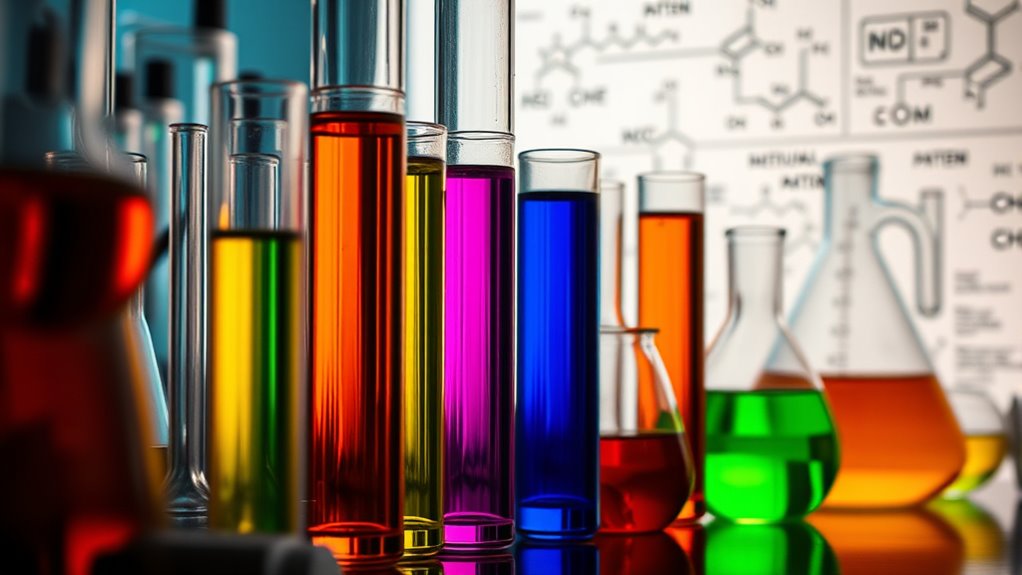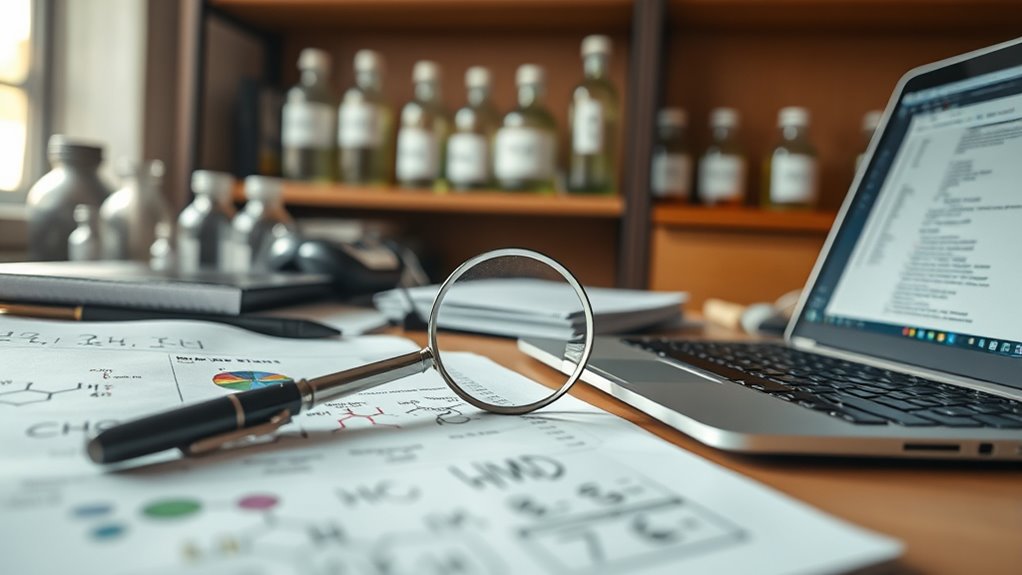To protect your new chemical inventions, you typically file a patent application that proves your discovery is novel, non-obvious, and useful. You’ll need to provide detailed descriptions, synthesis methods, and claims that define your invention’s scope. Patent examiners evaluate these to verify your compound or process isn’t already known. While patents grant exclusive rights, trade secrets are an alternative. Exploring these options further can help you secure the right protection for your innovations.
Key Takeaways
- New chemical inventions are primarily protected through patents that grant exclusive rights for typically 20 years.
- Patent applications must demonstrate novelty, non-obviousness, and utility, supported by detailed descriptions and claims.
- Conducting thorough prior art searches helps define patent scope and avoid infringement issues.
- Alternative protections like trade secrets safeguard proprietary formulas or processes without formal registration.
- International patent strategies, such as the PCT system, enable protection across multiple countries with a single application.
Understanding the Purpose of Chemical Patents

Chemical patents serve a crucial role in safeguarding innovations by granting inventors exclusive rights to their chemical inventions for typically 20 years. This protection prevents others from unauthorized use, reproduction, or sale of the invention, giving you control over your creation. They also encourage innovation by providing a period of market exclusivity. Chemical patents cover a broad range of innovations, including compounds, compositions, and methods of making or using chemicals. They act as a legal shield, especially in industries like pharmaceuticals, cosmetics, and chemicals, encouraging you to invest in research and development. Understanding the patent process can help inventors navigate the complexities of securing these protections effectively.
The Step-by-Step Patent Application Process for Chemical Innovations

When you’re ready to protect your chemical innovation, understanding the patent application process is key. First, identify if your invention is novel, non-obvious, and useful. Document your invention thoroughly, including experimental results and detailed descriptions. Conducting a prior art search utilizing tools like Thomson Innovation Patent Search Engine helps ensure your invention is truly unique by comparing it against existing patents. Conducting a thorough patent search early in the process can prevent potential legal issues and save time. Draft clear, precise claims to define the scope of protection. Conduct a prior art search to ensure no existing patents overlap with your invention. Consult with patent attorneys to ensure compliance with legal requirements. Gather all necessary information, such as process descriptions, compound characterization, experimental data, background research, and potential applications. When ready, file your application with the patent office, like the USPTO. During review, respond to examiner office actions and clarify issues through interviews. Once approved, maintain your patent by paying fees and monitoring infringement.
Key Components of a Patent Application in Chemistry

A well-structured patent application in chemistry hinges on several key components that establish the scope and validity of your invention. First, the patent application title must clearly identify your chemical invention, reflecting its scope accurately. A clear title helps examiners and patent offices understand the core of your invention from the outset. You need to list full names and residences of all inventors to establish inventorship. The application number and filing date are assigned upon submission for tracking purposes. Include technology classifications to categorize your invention within chemical patent systems. The specification must thoroughly describe your invention, including its composition, use, and how to reproduce it, supported by experimental results or examples. Clear, precise claims define your legal protection, covering compositions, synthesis methods, or uses. Supporting documentation, like invention disclosure forms, ties technical data to your application, ensuring compliance and completeness. Additionally, including detailed inventive steps can strengthen your application by demonstrating its novelty over existing technologies.
How Patent Examiners Evaluate Chemical Inventions

Patent examiners play a crucial role in evaluating the validity of your chemical invention by carefully analyzing its novelty, inventive step, and scope. They scrutinize whether your invention introduces a new chemical compound, use, or composition that’s not disclosed in prior art, including specific structures, formulas, or physical properties. Examiners assess if sub-range selections are genuinely novel, especially after the 2019 EPO update. They also determine if your invention involves an inventive step, ensuring it isn’t obvious to a skilled chemist and produces unexpected advantages. Clear descriptions are vital; your claims must be supported by detailed chemical structures, data, and synthesis methods. The scope must align with the description, avoiding overly broad or vague claims. Prior art searches help confirm the invention’s uniqueness and inventive merit. Examiners also evaluate whether the combination of known features produces surprising or unexpected effects, which can support inventive step.] Additionally, a thorough understanding of chemical structures and properties is essential for demonstrating the invention’s novelty and inventive step.
The Role of Chemists in Protecting New Compounds

Have you ever wondered how chemists help safeguard new chemical compounds? Your role is crucial in documenting and supporting patent applications. You generate detailed experimental data, including synthesis routes, structural drawings, and chemical properties, which demonstrate the novelty and utility of your inventions. Organic chemistry provides the synthesis and modification techniques necessary for medicinal chemistry efforts. By systematically modifying molecules through structure-activity relationships, you optimize compounds for effectiveness and safety, strengthening their patentability. Incorporating advanced analytical techniques ensures the accuracy and completeness of your chemical characterizations. Collaborating with patent professionals, you ensure that your chemical descriptions are precise, accurate, and compelling. Your thorough documentation and characterization serve as the foundation for patent claims, proving that your inventions are non-obvious and innovative. This meticulous work not only secures intellectual property rights but also safeguards your contributions to medical and scientific progress.
Strategies for Maintaining Patent Rights and Enforcing Them

Maintaining and enforcing patent rights require strategic planning and diligent management to guarantee your innovations remain protected. Begin by conducting regular patent portfolio reviews to assess each patent’s value and relevance. A well-maintained portfolio can significantly enhance your company’s valuation and market position. Prioritize high-value patents based on their strategic importance, and consider licensing or abandoning less critical ones. Centralize tracking of maintenance deadlines and fees to avoid lapses. Collaborate with international patent attorneys to ensure compliance with global laws and adapt your portfolio accordingly. Implement a tiered maintenance approach, focusing resources on patents with the highest return. Monitor for infringement through competitor activity and patent filings, engaging legal teams for enforcement when necessary. Proactively defend your patents, stay informed about international legal changes, and adjust your strategies to sustain your patent rights effectively. Regularly reviewing your patent lifecycle can help identify potential vulnerabilities before they are exploited by competitors.
Common Challenges Faced in Patenting Chemical Compounds

Charting the landscape of chemical patenting presents numerous hurdles rooted in the intrinsic complexity of chemical compounds. Legal frameworks often rely on lead compound analysis to assess obviousness, but chemical patents are highly technical, making clear disclosure difficult.
A thorough understanding of asset division laws can aid inventors and companies in structuring their patent rights to prevent future disputes. Explaining manufacturing processes and protecting complex structures, like drug delivery systems, adds layers of challenge. Patent language, crafted by lawyers, emphasizes protection over clarity, complicating enforcement. You face issues with inventiveness, especially when minor modifications, polymorphs, or conjugate chemistry create loopholes. The vast diversity of chemical structures makes searching and verifying patents complex. Additionally, high costs, regulatory hurdles, and the procedural intricacies of IPR challenges discourage many from defending their patents. Despite these obstacles, the legal system tends to uphold patents, underscoring the persistent difficulties in chemical patenting.
International Considerations for Patent Protection

Understanding the international landscape for patent protection is crucial for anyone looking to safeguard chemical inventions across multiple markets. Patent rights are territorial, so protection in one country doesn’t extend elsewhere, making strategic filings essential.
The World Intellectual Property Organization (WIPO) simplifies this with treaties like the Patent Cooperation Treaty (PCT), allowing you to file a single application that can later enter multiple national phases.
Timing matters: file early in major markets or within 12 months of your first filing to preserve priority.
You’ll need to take into account each country’s unique requirements, such as detailed disclosures and language rules, which can impact application success.
Working with experienced patent professionals ensures your filings meet local standards, maximizing your global protection and reducing delays.
Additionally, understanding ex-relationships can be metaphorically useful in managing international filings, as building trust and credibility across borders requires patience and strategic effort.
Alternatives to Patents: Trade Secrets and Other Protections

When considering alternatives to patents for protecting chemical innovations, trade secrets stand out as a flexible and cost-effective option. They involve keeping confidential information like formulas, processes, or sourcing details away from the public.
Unlike patents, trade secrets don’t require formal filings or disclosures, making them cheaper to maintain. As long as you keep the secret, protection can last indefinitely, providing a long-term competitive edge.
However, trade secrets aren’t foolproof—competitors can reverse engineer products or develop similar innovations independently. Internal leaks or breaches pose risks, and protection laws vary across countries.
In industries like pharmaceuticals and chemicals, trade secrets are especially valuable for safeguarding proprietary information vital to maintaining market advantage without the time limits of patents. Additionally, choosing between trade secrets and other forms of protection, such as home security systems, depends on the nature of the innovation and the specific risks involved.
The Impact of Patents on Innovation and Market Success

Patents play a crucial role in driving innovation and shaping market success by providing inventors and firms with exclusive rights to their chemical inventions. This encourages increased research activity, as firms engaged in patent races conduct about 14% more follow-on research. Industries with high patent activity, like semiconductors and chemicals, frequently introduce new or improved products. Larger firms value patents highly, linking them to growth strategies and economic productivity. Patents also protect inventions, enabling companies to secure market share, command premium pricing, and create barriers for competitors. The surge in global patent filings—3.5 million in 2023—reflects rapid innovation. Patent searches further reduce infringement risk by 60%, fostering efficient development. Cultural and Regional Breakfasts have historically spurred innovation in food preparation methods and recipes, influencing patentable culinary techniques. The table below highlights these impacts:
| Innovation Activity | Market Advantages | Global Trends |
|---|---|---|
| Increased R&D | Market Share Growth | Record Filings |
| Follow-on Research | Customer Loyalty | Sector Growth |
| Patent Valuation | Competitive Barriers | Strategic Focus |
Frequently Asked Questions
How Long Does It Typically Take to Get a Chemical Patent Approved?
You’re wondering how long it takes to get a chemical patent approved. Usually, the process takes between 1 to 3 years, depending on factors like invention complexity and workload at the patent office.
Filing a provisional application can give you a year of “patent pending” status, but the formal review starts with a non-provisional application, which undergoes detailed examination before approval.
Patents last 20 years from the filing date.
Can Existing Compounds Be Patented if Modified Slightly?
Did you know that over 60% of patented inventions involve some form of modification? You can patent existing compounds if you make a slight but significant modification that results in a new, non-obvious property or use.
To succeed, you need to prove the modification’s novelty and technical benefits, ensuring it’s not an obvious step to someone skilled in the field. Conduct a thorough prior art search to strengthen your patent application.
What Are Common Reasons for Patent Application Rejections in Chemistry?
You might face rejection because your chemistry patent application overlaps with existing prior art, making it lack novelty. Examiners often cite references showing your invention isn’t sufficiently new or obvious.
Additionally, vague claims, poor descriptions, or incomplete disclosures can cause issues. Missing deadlines or failing to respond properly to office actions also lead to rejection.
To improve your chances, guarantee your application clearly demonstrates how your invention is unique, inventive, and well-documented.
How Do International Patent Treaties Affect Chemical Patent Filings?
International patent treaties simplify, standardize, and secure your chemical patent filings. They streamline your process through single applications, making it easier to seek protection in multiple countries.
They standardize legal standards, ensuring consistent protection worldwide. They secure your rights against infringement, boost your market access, and foster innovation.
What Role Does Prior Art Play in Patent Approval Decisions?
Prior art plays a critical role in your patent approval process. It helps examiners determine if your chemical invention is truly new and non-obvious by comparing it to existing knowledge.
If prior art shows your invention isn’t novel or is obvious, your application can be rejected or require amendments. Being aware of all relevant prior art, including published applications and earlier filings, can improve your chances of securing a patent.
Conclusion
Protecting your chemical inventions with patents is essential for safeguarding your innovation and gaining market advantage. Did you know that over 90% of new drugs rely on patent protection to recoup research costs? By understanding the patent process and overcoming common challenges, you can secure your breakthroughs and foster continued innovation. Embrace these protections, and you’ll boost your chances of success in the competitive world of chemistry.









